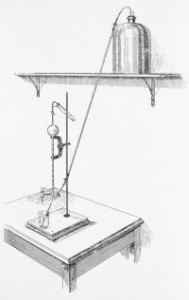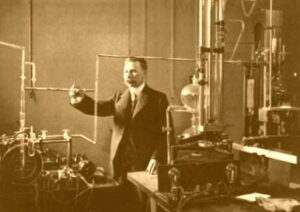The determination of salinity, as the total measure of inorganic dissolved matter, is by evaporation of the water and weighing of the residue. This is a difficult process because some carbon dioxide and hydrogen chloride escape during the evaporation process and corrections must be made for this. Furthermore, at sea, these methods involving weighing can not be used. So the methods to be applied onboard a ship has to be indirect ones.
In the past century, only two major methods have been used in oceanography for the measurement of the seawater samples’ salinity: chlorinity titration and conductometry.

- Chlorinity Titration
Chemical determination of halide content by titration was for many years the usual routine method for determining the “sea salt” content of seawater samples. This method, which is known as the Mohr method (Mohr, 1856), consists of titrating a sample of seawater with silver nitrate solution of known concentration to the point where all halides (chloride plus a small amount of bromide ) have been precipitated as silver halide, as detected by suitable indicators or electrode systems. A 15ml Knudsen pipette is used to measure the seawater sample in the titration vessel. This pipette differs from the standard type in that, after filling, the volume of the sample is defined by the rotation of a 3-way stopcock fitted at the upper end.
Clu = Cls × Tu × Ws \ Ts × Wu
where:
Clu and Cls – chlorinity of unknown and standard,
Wu and Ws – the weight of unknown and standard,
Tu and Ts – silver nitrate titre for unknown and standard.

A modification of the Knudsen titration has been suggested by Grasshoff and Wenk (1972). This uses a Metrohm incremental piston burette in place of the Knudsen burette; the absence of greased stopcocks from the system is stated to improve the convenience and accuracy of the shipboard analysis markedly.
Potentiometric endpoint determination has been utilized by several workers to enhance the precision of silver nitrate titration. Reeburgh and Carpenter (1964) used a differential electrochemical system for endpoint detection.

One of the major drawbacks of manual titration methods lies in the time taken per sample and the operator’s skill required. A semi-automatic method of chlorinity titration has been described (Jarner and Aren,1970) which reduces the time per sample to 5min while retaining high precision (0.004‰ in chlorinity).
Chlorinity was then converted to salinity by means of the equation:
S = 0.03 + 1.805Cl
or later equation:
S = 1.80655Cl
prior to the introduction of the Practical Salinity Scale 1978. Chlorinity is now regarded as an independent chemical parameter to describe the properties of seawater and has no defined relationship to salinity.
2. Electrical Conductivity.
In the past sixty years, chlorinity titration, which was time-consuming and required a certain degree of analytical skill, has been largely replaced by the measurement of electrical conductivity as a means of estimating salinity. In general terms, conductivity is a measure of the total ion concentration of the water. The use of conductivity measurements for the determination of salinity was suggested more than 100 years ago by M. Knudsen (1903), but until the advent of sophisticated electronic circuitry, the method was incapable of achieving the precision and reliability of the chemical method.
The conductivity of an electrolyte solution was determined by means of a bridge circuit whereby the resistance of the cell containing the electrolyte was compared with the resistance of a standard solution.

The laboratory method consists of comparing by using salinometers the electrical conductivity of the sample with that of a standard (IAPSO Standard Seawater) of known salinity at the same temperature.
The measured conductivity ratio is then converted to the practical salinity by means of the equation of the PSS-78.
(be continued)







 Visit Today : 20
Visit Today : 20 Visit Yesterday : 196
Visit Yesterday : 196 This Month : 4420
This Month : 4420 Total Visit : 194751
Total Visit : 194751 Hits Today : 21
Hits Today : 21 Total Hits : 539188
Total Hits : 539188 Who's Online : 2
Who's Online : 2